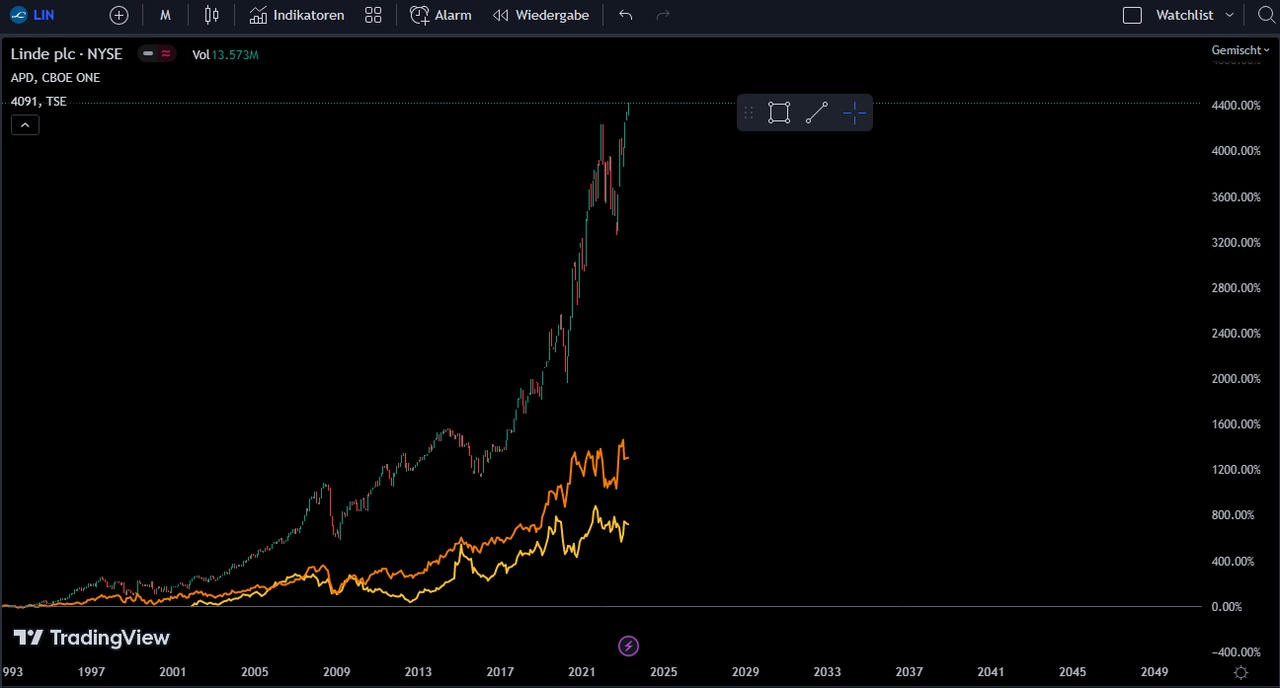++Linde and other industrial gas producers in comparison++
1. business model of $LIN (+0,76%)
1]
Linde PLC is an industrial gases and engineering company. The company's business consists of two core product lines: Industrial Gases and Engineering. The main products of the industrial gases business are atmospheric gases such as oxygen, nitrogen, argon and noble gases, and process gases such as carbon dioxide, helium, hydrogen, electronic gases, specialty gases and acetylene.
The company designs, engineers and builds industrial gas production plants and provides customers with a range of gas production and processing services, such as olefin plants, natural gas plants, air separation plants, hydrogen and synthesis gas plants and other types of plants.
Employee Satisfaction: [2]
Average rating:
According to the review portal kunuu, workers are satisfied with their employer on average. The company scores a 3.4 out of 5, and has a 50% recommendation rate. The biggest problem of the German workers stands out more clearly: the aggressive company culture. Many layoffs and poor chances of being hired.
Salary:
The majority of workers are happy with salaries at Linde. And rightly so. Rich starting salaries attract qualified employees to the company. Key positions at the company would include:
Engineer: 80,500€ / Buyer: 85,300€ / Project Manager: 97,900€.
General:
It should be noted that I underestimated Linde quite a bit. I was aware that Linde is a big player in the gas business, but the fact that Linde is the world market leader in industrial gases [3], besides AirLiquid, surprised me quite a bit. The chart alone in comparison to Airproducts and Shin-Etsu is a real treat... (picture is attached/ By the way, I would appreciate it if you could finally insert pictures between text, this would help the reading flow significantly)
Is Linde "too big to fail"?
Modern industrial gases are one of the components that make up the engine of modern industry. Without industrial gases, many "normal" products such as plastics or fertilizers would no longer be able to be manufactured. Industrial gases are accordingly indispensable! For example, without chlorine and ethylene, plastic could no longer be produced, or without nitrogen and ammonia, ammonia could no longer be produced. It is also interesting to note that without argon and helium, the semiconductor industry would no longer be able to produce (all products of Linde).
Prospects for industrial gases: [4]
Political and societal pressures, at least here in Germany, are increasing demand for alternatives to conventional oil, benefiting low-CO2 technologies such as hydrogen. In addition, more efficient mechanisms are being invented to improve the efficiency of industrial gases. Whether hydrogen propulsion will become widely accepted as a replacement for the internal combustion engine is questionable - industrial gases already seem to be more attractive for large means of transportation such as trucks or even airplanes. As already mentioned above, industrial gases are indispensable for chemical/medical and some technological industries.
2. key figures in comparison (Linde(DE) vs. Airproducts(USA) $APD (-0,96%)
vs. Shin-Etsu $4063 (-0,3%)
(JPN)) [5]
a. Sales and profit growth (EBIT)
Sales growth over the last 5 years:
Linde: 23.88% / Airproducts 9.17% / Shin-Etsu 3.18%
EBIT growth over the last 5 years:
Linde:
- 2018-2019: (-42%)
- 2019-2020: (15,61%)
- 2020-2021: (50,68%)
- 2021-2022: (8,71%)
- Average growth rate: 6.6%
Airproducts:
- 2018-2019: (13,62%)
- 2019-2020: (5,87%)
- 2020-2021: (3,45%)
- 2021-2022: (9,86%)
- Average growth rate: 6.56%
Shin-Etsu:
- 2018-2019: (22,4%)
- 2019-2020: (2,58%)
- 2020-2021: (-5,6%)
- 2021-2022: (73,11%)
- Average growth rate: 18.5%
Average 5-year EBIT growth trend:
Linde: 6.6% / Airproducts: 6.56%/ Shin-Etsu 18.5%.
b. All about the dividend
When it comes to dividends, my focus is on sustainable growth. I avoid companies that already have too high a payout ratio, or which barely increases the dividend. Interesting ratios for this are:
- Current dividend yield
- Dividend continuity
- Dividend growth
- Payout ratio
Linde:
- Current dividend yield: 1.30%
- Dividend continuity: 30 years
- Dividend growth: (5 years: 8.27%); (10 years: 7.84%)
- Payout ratio: approx. 60%
Airproducts:
- Current dividend yield: 2.2%
- Dividend continuity: 35 years
- Dividend growth: (5 years: 11%); (10 years: 9.5%)
- Payout ratio: approx. 60%
Shin-Etsu:
- Current dividend yield: 2.13%
- Dividend continuity: 25 years
- Dividend growth: (5 years: 10%); (10 years: 9%)
- Payout ratio: approx. 55
c. Low debt
In order for a company to be flexible even in high-interest phases, it should have low debt. I personally equate a high equity ratio with security.
Equity ratio:
Linde: 50.25%
Airproducts: 48.34
Shin-Etsu: 82.4%
3. outlook
I expect my investment to grow steadily in the future and to pay me a nice dividend. Admittedly, none of the companies offers a high dividend yield, and to be honest, I don't have a clear favorite among the three stocks. Linde and Airproducts are the bigger companies, but they have already had their big growth spurts. Shin-Etsu is a small but interesting company, but can it really compete with the big top dogs. According to the current market distribution, Airproducts and Linde are ahead - Linde even a bit more. However, Linde has already done very very well, and has almost three times the market capitalization of Air Products. I will decide in the coming weeks whether to bet on Linde or Air Products, and then open a position for my dividend portfolio.
I will publish the purchase again in GQ.
Final question: Which stock would you buy?
By the way, the outline of this post is inspired by the post of @RealMichaelScott (How to analyze a dividend stock). And on the topic of hydrogen I was inspired by the post of @Hannes_SK (Bye-Bye $PLUG (-2,08%) )
Sources:
[1]: https://de.marketscreener.com/kurs/aktie/LINDE-PLC-46923083/unternehmen/
[2]: Linde Erfahrungen: 711 Bewertungen von Mitarbeitern | kununu
[3]: Industriegase: Marktanteile größter Hersteller weltweit 2018 | Statista
[4]: Industriegase: Hersteller, Produktion und Anwendungen - Gasido.de
[5]: TraderFoxx; marketscreener; finanzen.net
#wasserstoff
#linde
#zukunft
#stockanalysis
#etfs
#aktien
#dividenden
#dividendencheck
#dividendenaktie
#geldanlage











